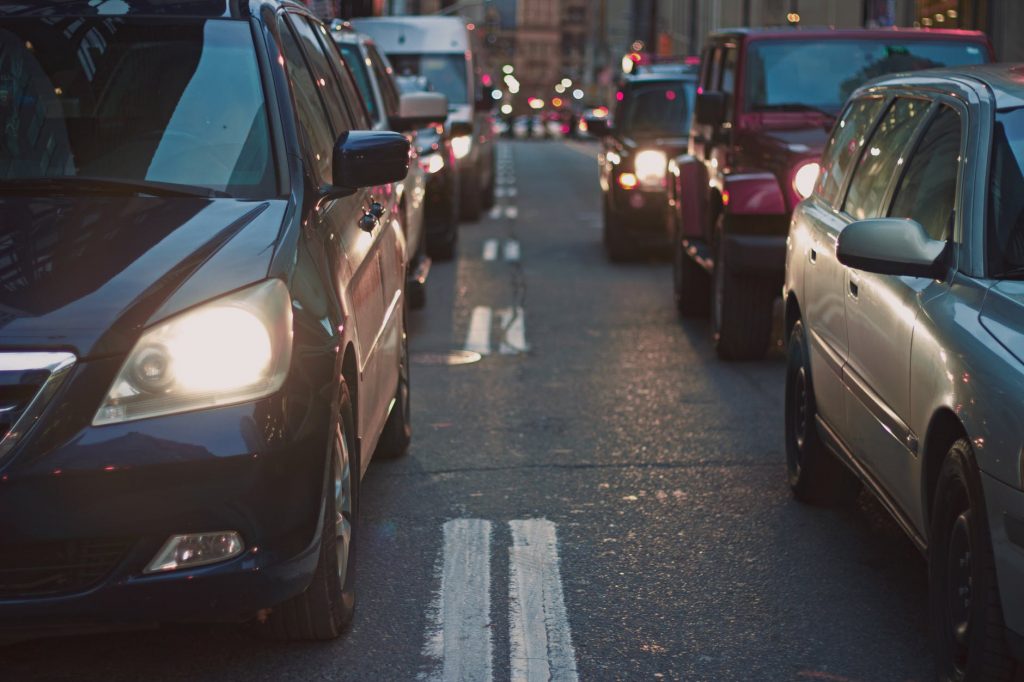
In the last 24 years the United States has created over 30,500 miles of road, a 42% increase in road building. Commensurate with that is congestion, which has increased by 144 % in the same time period. A new report from Smart Growth America called The Congestion Con examines American highway construction and breaks down the costs.
“Each lane-mile of road costs between $4.2 and $15.4 million to build and another $24,000 a year to maintain. States alone spent $500 billion to expand roads between 1993 and 2017.”
Think of it~that is just the capital outlay and does not factor in pollution or the cost of crashes. This is induced demand at its finest, with more roads and lanes appearing to speed up traffic, but just fills up with more cars. In fact a California researcher discovered that each percentage of extra road capacity created produced the same amount of miles traveled.
As more roads get built, people commute farther and the statistics in this report prove it. Since 1993, the average American driver commutes an extra four miles a day.
One way to mitigate congestion is to build transit infrastructure and to incentivize it. In Seattle bus trips grew as a percentage from 42 percent to 58 percent in seven years, with a decrease in single occupancy vehicle trips to 25 percent. Housing infill in denser neighbourhoods and cycling and walking infrastructure also aims to assist people in commuting less and more sustainably.
Despite the congestion gains found in slowing traffic, densifying downtowns and building resilient transit systems, many transportation planners and politicians still plan roads the way they always did, thinking roads will solve congestion issues. Politicians focus on congestion “symptoms” instead of causes.
You just can’t build your way out of congestion with new roads and bridges.What you can do is support denser cities, active transportation, and revamped transit options offering alternatives to travel by vehicle. Add road pricing to private vehicular use, and all of a sudden transit is a viable option.
What will it take for the “congestion mindset” to change?

Photo by Alin Olariu on Pexels.com













Given that the BC gov’t is committed to widening Highway 1, why not make the new lane a toll lane and/or high occupancy vehicles only?
Tolling access to it would begin introducing road pricing in the Lower Mainland, the key to reducing congestion with other existing roadways.
Denser cities mean denser traffic no matter what form the traffic takes. Denser cities mean that there will be a lot of non-mass transit traffic (congestion). The congesters are the ones building and servicing the city and its’ buildings, buying and selling real estate, feeding and pampering its population with diverse services and items of industrial age luxury and necessity. We are living in a 24/7 factory. There will be congestion.
We can solve this whole situation by reducing the demand that leads many of the congesters to congregate, namely by locating new jobs in new places where people can both live and work, places where there is no need to commute. New pop up walking cities where cars have no road space. Make those new jobs, green jobs, and make those new cities all electric. Please.
It’s all how how how instead of why why why.
I used to commute by car, to the North Shore, to do a poverty level wage slave job, to help a multi-billionaire make more money.
If he had to pay for my commute, he would have hired locally. Problem solved.
People often say that it’s hard to make money here, but there is obviously a ton of cash – in the hands of the psychopathically greedy – greedy for cash, influence, power over wage slaves.
How about rezoning to eliminate single family houses to free up space for multi-family projects closer to the downtown?
How about eliminating the Home Owners Grant to force retired people out of their underutilized single family houses to free them up for redevelopment?
How about censoring home improvement television shows that depict expansive living spaces and big back yards? (ie temper expectations)
How about more municipal town centres within the City of Vancouver (Oakridge is the only one, not counting the Metropolitan Core) and building them as dense as Burnaby allows?
“Guest” prefers to screw many good citizens, esp. those pesky old people – to preserve the grotesque wealth of a few.
Those pesky old people would likely make a tidy profit from the sale of their houses.
Gas is too cheap. That’s the only reason this is still a conversation.
No EVs? No one wants SFHs or at least a TH with a yard anymore? No one has kids anymore? Immigrants come here with dreams of being a perpetual renter in a small unit?
That’s not the BC I live in and immigrated to !!
Well, it’s the one I live in and immigrated to, with kids. Owning is strictly for suckers.
Note that you need to distinguish between the manner of occupancy – rental vs ownership and the form of occupancy – expansive house vs compact apartment
I agree that the political of road pricing are fraught with razor edges, but the purported principle at play was “fairness”- so it might seem fair that if the Fraser Valley was getting a new lane, that it would be fair to introduce optional (dynamic) tolling for those who would want to pay. Everyone would still benefit in the short term from the new lane.